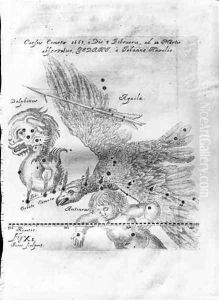Johannes Hevelius Paintings
Johannes Hevelius, born on January 28, 1611, in Danzig (Gdańsk), in the Polish-Lithuanian Commonwealth (now Poland), was not only an eminent astronomer but also a skilled brewer and city councilor. His family was of German origin, and Hevelius was brought up in a wealthy and influential merchant family. He received a comprehensive education in humanities and sciences, which ignited his lifelong passion for astronomy.
After completing his studies at the Gymnasium of Danzig, Hevelius traveled extensively, visiting prominent centers of learning and meeting with noted scholars across Europe. He eventually returned to Danzig, where he took over the family's brewing business and became deeply involved in civic duties. However, his fascination with the stars never waned, and he dedicated much of his time and resources to the study of the heavens.
Hevelius was a diligent observer of the sky and is noted for his contributions to the field of lunar topography. He erected an observatory on the roofs of his homes, equipped with state-of-the-art instruments, some of which he designed and constructed himself. His observatory, known as 'Sternenburg' or 'Star Castle,' became famous and attracted many notable scientists and dignitaries of his time. Hevelius is particularly remembered for his detailed moon maps, which he published in his work 'Selenographia' in 1647. This treatise was the first lunar atlas and is considered one of the greatest achievements in lunar cartography, offering the most comprehensive and accurate depiction of the lunar surface available at the time.
In addition to his lunar studies, Hevelius compiled a star catalog and published several celestial atlases, including 'Prodromus Astronomiae' and 'Firmamentum Sobiescianum,' the latter being named in honor of his patron, King John III Sobieski of Poland. His work featured numerous new constellations, many of which are still recognized today.
Despite suffering a devastating fire in 1679 that destroyed his observatory, instruments, and many of his unpublished observations, Hevelius was resilient. With support from fellow scientists and patrons, he continued his work until his death on January 28, 1687. His second wife, Elisabeth Koopmann Hevelius, an accomplished astronomer in her own right, aided him in his later years and published his last great work, 'Prodromus Astronomiae,' posthumously.
Johannes Hevelius is remembered as one of the most distinguished astronomers of the 17th century. His meticulous observations, without the aid of a telescope's crosshairs, challenged and contributed to the accuracy of celestial measurements. His legacy lives on in the maps of the moon and the stars that he so passionately charted.
